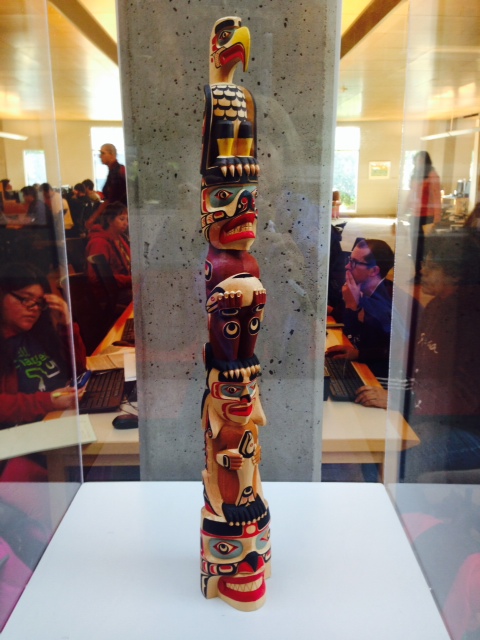This content was published: November 10, 2014. Phone numbers, email addresses, and other information may have changed.
Meet the images depicted in The Welcoming Pole
Photos and story by Amy Mintonye
November 18, 2014

A small replica of Richard Hunt’s Welcoming Pole is housed in the PCC Sylvania library. It offers an intimate look at all of the totem’s images.
PCC Sylvania’s Welcoming Pole was carved in the Kwakwaka’wakw style by renowned Kwa-Guilth artist Richard Hunt of British Columbia, Canada. A totem pole can be a memorial or burial marker; it can identify and communicate the status of a clan and its members. Here are the images depicted on The Welcoming Pole:
Eagle: The eagle is the main crest of Hunt’s family, which is originally from Fort Rupert, British Columbia. Among the Kwakwaka’wakw and other Northwest Coast peoples, the eagle is usually considered to be the most important crest; members of the eagle clan often assume political and cultural leadership positions.
Sisiutl: The supernatural two-headed serpent is a crest of Hunt’s mother, Helen Nelson Hunt. The sisiutl is usually portrayed as a serpent with a head at each end and a third face in the center. Here, Hunt has carved only its central face, which he interprets as a sea monster.
Man holding salmon: This figure also illustrates the importance of salmon as a food. It is meant to represent a Kwakwaka’wakw ceremony associated with the first salmon of the year. When the first salmon is caught, it is cleaned and its remains are returned to the sea. This is mean to give thanks as well as to be a prayer for the salmon to return each year.
Salmon is traditionally the main source of food for Native Peoples of the Northwest Coast, as well as for those living along the Columbia River and Western Oregon. Hunt sees the salmon as a connection between the peoples of the two regions, which is why he included it as one of the pole’s main images.
Bear: The bear is another major crest for the Native People of the Northwest Coast and is part of several ceremonial dances. Bears are found throughout the region and are admired for their strength and skill as hunters. Here the bear is holding a salmon, emphasizing the importance of salmon as a resource for both animals and humans.
Moon: Richard Hunt considers the moon (a large face on the back of the bear) to be a filler element and has taken a certain amount of artistic license with it, meaning it either to be the moon or a human face; the whimsical depiction is meant to put students in a happy mood as they head to and from class.
– Portland Community College
